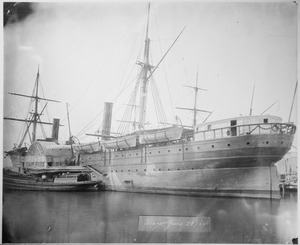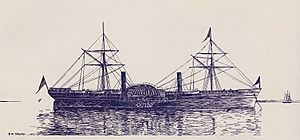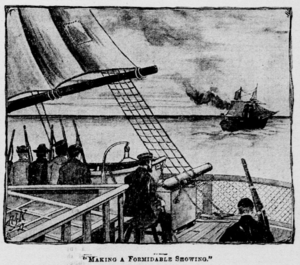SS Arago (1855) facts for kids

Arago in 1864
|
|
Quick facts for kids History |
|
|---|---|
| Name | Arago |
| Owner | New York & Havre Steam Navigation Company |
| Operator | Captain Henry A. Gadsden |
| Port of registry |
|
| Builder | Jacob A. Westervelt's Sons & Company, New York, New York |
| Launched | January 27, 1855 |
| Completed | 1855 |
| Maiden voyage | June 2, 1855 |
| Fate | Sold to Peruvian Government, 1869 |
| General characteristics | |
| Type | Wooden-hull Sidewheel steamer |
| Tonnage | 2,240 GRT |
| Length | 295 feet |
| Beam | 40 feet |
| Installed power | Two oscillating steam engine by Novelty Iron Works of New York |
| Propulsion | Iron Paddle Wheels, 33 feet diameter |
| Speed | 12 knots (22 km/h) |
| Armament | 4 rifled cannon (of unknown caliber) |
The Arago was a large wooden ship built in 1855. It was a special type of ship called a sidewheel steamer, meaning it used big wheels on its sides to move through the water. The ship was built by Westervelt & Sons in New York City.
During the American Civil War, the Arago was used by the Union Army. It helped transport soldiers and supplies. It also worked with the South Atlantic Blockading Squadron to stop enemy ships. In April 1865, the Arago had the important job of returning the United States flag to Fort Sumter. After the war, it went back to carrying passengers and goods across the Atlantic Ocean. The ship was sold to the Peruvian government in 1869.
Building the Arago
The Arago was built in 1855 by Westervelt and Sons. Its sister ship was the SS Fulton. Both ships were made for the New York & Havre Steam Navigation Company. This company had a contract with the U.S. Government to deliver mail between New York and Havre, France.
The Arago was named after François Arago, a famous French scientist. These ships were much better than older ones. They had special engines and strong, watertight sections. This made them safer and more powerful. The Arago was built to replace another ship, the Humboldt, which was lost at sea. It cost 450,000 dollars to build.
The Arago was launched in January 1855. Its first trip, called a maiden voyage, was on June 2, 1855. Captain David Lines was in charge. On this trip, the ship carried 215 passengers and a lot of money.
Ship's Journey Through Time
From 1855 to 1861, the Arago was a mail steamer. It traveled across the Atlantic Ocean. It carried people, goods, mail, and money. Its main stops were New York, Southampton, Liverpool, and Le Havre.
The Arago was officially listed as a pilot schooner from 1858 to 1969. Captain Gadden was its master, or main captain. The New York & Havre Steam Navigation Company owned the ship.
In June 1859, Gamaliel Bailey, a person who worked to end slavery, died on the Arago. He was on his way to Europe.
In December 1859, the Arago brought Senator William H. Seward back from Europe. He had been on an eight-month trip. When he returned, he tried to become the Republican candidate for president.
Mail service stopped in March 1861 because the American Civil War began. The Arago's last mail trip started on March 30, 1861.
The American Civil War Years
From 1861 to 1865, the U.S. Department of War rented the Arago. It was used as an army transport ship. The cost was 1,200 dollars per day. Captain Lines and Captain Henry A. Gadsden took turns commanding the ship in 1861.
In November 1861, retired General Winfield Scott traveled to Europe on the Arago. He was with newspaper publisher Thurlow Weed. Their trip was called a vacation. But General Scott's real goal was to get France to support the Union. This was important because Great Britain might have fought against the Union.
Soon after they left New York, a U.S. Navy ship stopped a British ship. It removed two Confederate diplomats. This event was called the Trent Affair. It almost caused a war with Great Britain. General Scott quickly returned to New York. He signed a letter saying the U.S. government did not order the action. His quick actions helped prevent a war with Great Britain.
In December, people worried about the Arago's safety. A Confederate ship, the CSS Nashville, was in Southampton. It had just burned an American merchant ship. People feared the Arago might be attacked too. But these fears were wrong. The Arago returned safely to New York.
Captain Gadsden then became the full commander of the Arago. He stayed in command until the end of the war.
For a short time in 1862, the Arago was used by the U.S. Navy. This was ordered by Edwin M. Stanton, the Secretary of War. The Confederate ironclad ship CSS Virginia had attacked Union ships. The Arago and other ships were sent to Hampton Roads, Virginia. They were supposed to ram the Virginia if it came out again. The civilian crew of the Arago was not told about this dangerous mission until they arrived. Many crew members refused to do it and left the ship. Naval officers and other civilians, including nine runaway slaves, joined the crew. The Virginia was later sunk by its own crew. After this, the Arago went back to transporting troops and equipment for the Union army.
On July 26, 1863, the Arago was full of wounded and sick soldiers. They were from battles at Fort Sumter and Fort Wagner. The ship saw another ship off Wilmington, North Carolina. The other ship sped up and threw cotton bales overboard. Captain Gadsden chased it for seven hours. The Arago caught the slower ship. This led to the capture of the Confederate blockade-runner Emma. No shots were fired during the chase or capture.
The Arago kept transporting troops, equipment, and mail until the war ended. On May 8, 1865, the Fort Sumter Flag was taken from a bank vault in New York. It was put on the Arago. Major General Robert Anderson and Sergeant Peter Hart, along with other important people, were also on board. The Arago took the flag to Fort Sumter. Four years after it was lowered in surrender, Major Anderson and Sergeant Hart raised it again. This celebrated the Union's victory.
After the War
After the war, the Arago's owners fixed it up. They put in new boilers and repainted everything. The cabins were also newly furnished. They hoped the ship would be as popular as it was before the war. The Arago left New York on November 25, 1865. Captain Henry A. Gadsden was still in command. It carried 40 passengers and a cargo of cotton. The ship was sold in December 1866. It continued to operate until the autumn of 1867, when it stopped service.
In 1868 and 1869, the Arago and its sister ship Fulton were briefly rented by Ruger Brothers for passenger service. But without government money for mail service, these ships were too expensive to run. Newer, more efficient ships were also competing. In December 1868, the Arago survived a bad storm at sea. It was traveling from New York to Falmouth, England.
After two round trips for Ruger American Lines, the Arago was sold to the Peruvian government in 1869. The Fulton was too old and broken up for scrap. After the Arago left for Peru, some people claimed it was carrying soldiers and weapons to help a revolution in Cuba. This was later found to be untrue. The Arago was believed to still be in Peruvian service as late as 1912.



